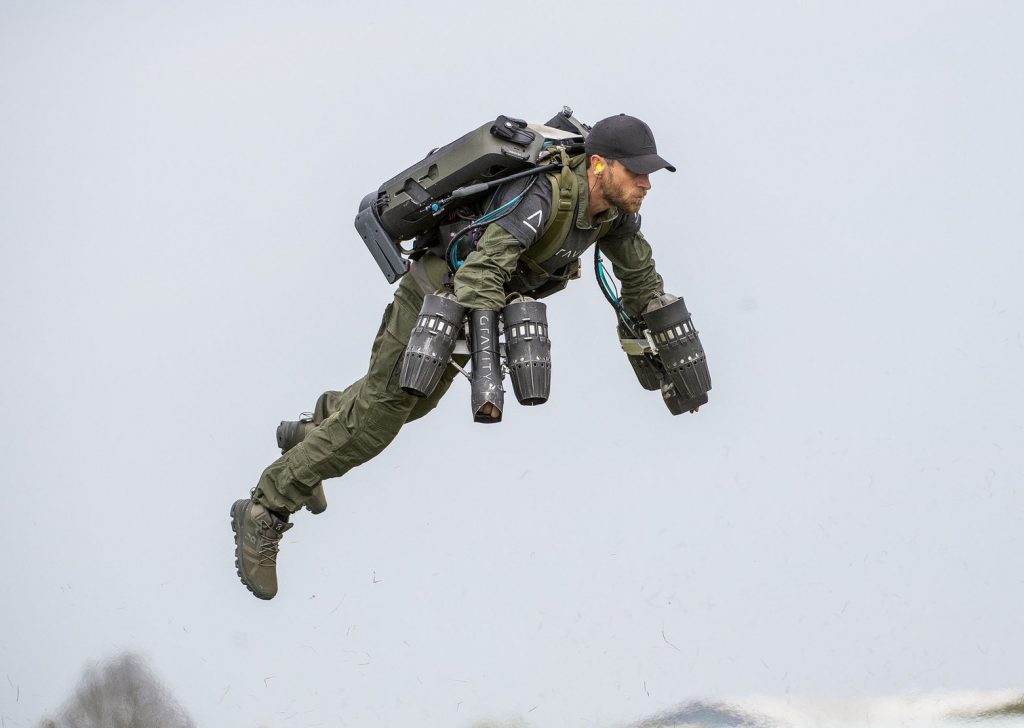UK-based jetpack manufacturer Gravity Industries has partnered with 3D printing service provider Ricoh 3D to develop a next-generation electric version of its human flight suit.
Known as the ‘Gravity eSuit,’ the upgraded jetpack features an array of flexible 3D printed polypropylene (PP) internal flow parts, which not only provide ventilation but fit organically to the wearer, making it seem like they’re flying independently. Designed to “blend mind, body and machine,” Gravity Industries’ latest iron-man-like suit is set to debut at the 2021 edition of the Goodwood Festival of Speed.
“We’ve been on an incredible journey with Gravity Industries so far. AM has helped them take what might seem like an impossible idea and turn it into reality, by harnessing the unique properties of PP,” said Mark Dickin, head of Ricoh’s European 3D printing operation. “By pushing the boundaries with both 3D printing and PP, we’re showcasing what’s possible when you have the right expertise and ingenuity.”
“3D printed polypropylene is 90% recyclable, lightweight and flexible while still being incredibly durable– ideal for taking to the skies.”
Gravity takes to the skies
Since first being developed by its Chief Test Pilot Richard Browning in 2016, Gravity’s jetpack has successfully conducted 105 live flight events in 31 countries, including UK search & rescue and military demonstrations. In one such instance, the jetpack was even used to conduct a ‘visit, board, search and seizure’ exercise, during which Browning was able to ‘infiltrate’ the HMS Tamar by flying onboard on the move.
Now on its third iteration, the Gravity Jet Suit packs two miniature jet engines on each arm, as well as a fifth housed in its backpack. By creating over 300 pounds of thrust with its 1,050 brake horsepower engines, the device is reportedly capable of propelling a 200 lbs person for up to seven minutes, albeit at a suitably astronomical price tag of $440,000.
In the past, Gravity has partnered with 3T Additive Manufacturing to print aluminum-based arm mounts for its jetpack, that not only proved lighter but helped integrate multiple parts into a single streamlined unit, and the firm has now taken a similar approach to working with Ricoh 3D, with the aim optimizing the design of its upcoming electric flight suit.
“I’ve always had a passion for unusual challenges and venturing into the unknown, so it’s incredible to see the dream ignite into life,” said Browning. “We’ve built up an amazing global footprint since [Gravity was founded in] 2017, and Ricoh has enabled us to transform an ‘impossible’ idea into something viable for production.”

Introducing the ‘eSuit’
In the early R&D of its new eSuit, Gravity sought to find a material that could mimic organic matter, but was also flight-capable, comfortable and safe. To achieve this, the firm turned to Ricoh 3D printing and its flagship PP, which has since provided it with the flexibility to prototype with end-use materials, expediting the development of its next-gen suit.
In doing so, Gravity has also been able to iteratively tweak its jetpack’s design without making new moldings or starting from scratch, reducing its time taken to manually build a core suit structure out of aluminium riveting from two weeks, down to just 24 hours of 3D printing and two days’ assembly.
What’s more, PP’s inherent strength, lightness and flexibility has enabled Gravity to reduce the part count of its eSuit significantly, integrating several assemblies into one. The resulting multifunctional units have fewer glued or bolted-on components and feature internal flow parts which move air through the suit, and this, according to Ricoh, will “push the boundaries of what we think humans are capable of.”
“Ricoh are experts in AM, which has helped us produce the Jet Suits to the standard and quality that we wanted,” said Gravity’s Chief Designer, Sam Rogers. “There was no need to produce hundreds of prototypes, so the process was much simpler and enabled us to focus on what really matters – overcoming the ‘impossible’ and creating a suit that perfectly augments the human body.”
“Thanks to PP and its organic nature, people see a human who is flying when someone is in the Jet Suit. They aren’t strapped into a device or seated in a vehicle, they appear to be genuinely flying.”
Advances in AM rocket engines
Of course, jetpack technology remains at an early stage of development, but 3D printing has also been used to manufacture larger-scale rocket engines with great efficacy in the aerospace sector. Back in May 2021, propulsion system manufacturer Aerojet Rocketdyne announced that an upgraded version of its 3D printing-optimized RL10 rocket engine had passed NASA hot-fire testing.
In a similar vein, U.S. space technology startup Rocket Crafters Inc (RCI), recently wrapped up the initial testing of its 3D printed Comet Series Hybrid rocket engine. Conducted over a series of 49 laboratory tests, the company’s latest test firings were designed as a large-scale proof-of-concept ahead of a planned test flight.
NASA itself has also experimented with 3D printed rocket engine components, completing 23 hot-fire tests on two such parts in December last year. In early evaluations, the copper alloy combustion chamber and iron-nickel superalloy nozzle proved capable of withstanding the extreme heat they’d usually be exposed to during space flight.
To stay up to date with the latest 3D printing news, don’t forget to subscribe to the 3D Printing Industry newsletter or follow us on Twitter or liking our page on Facebook.
For a deeper-dive into additive manufacturing, you can now subscribe to our Youtube channel, featuring discussion, de-briefs and shots of 3D printing in-action.
Are you looking for a job in the additive manufacturing industry? Visit 3D Printing Jobs for a selection of roles in the industry.
Featured image shows Gravity Founder Richard Browning testing the existing version of the firm’s Jet Suit. Photo via Gravity Industries.



